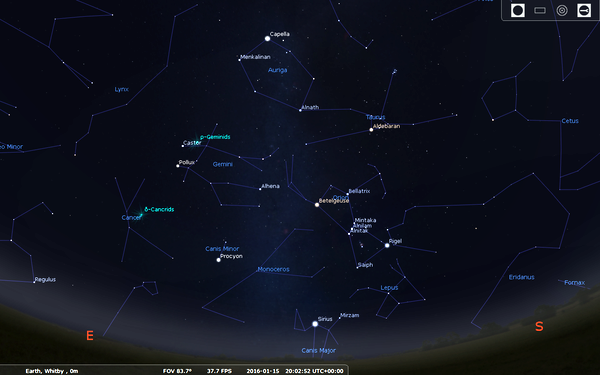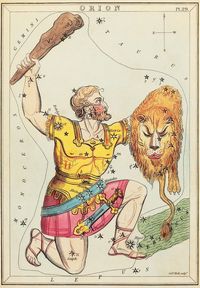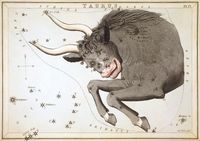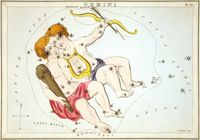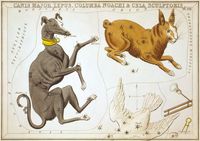One of the most impressive stellar panoramas is the jewelled canopy of the winter night sky, in particular the southern aspect, adorned as it is with imposing constellations and studded with an array of brilliant stars. Rich in both mythology and observational interest, there is plenty here to reward an observer, whether using binoculars, a telescope or just the naked eye.
Standing at the heart of this glittering tableau is the mighty hunter, Orion, located to south during mid January evenings. The main outline is quite distinct, a sloping line of 3 stars set in the midst of a larger stellar rectangle. Two of these stars, in opposing corners, are real super luminaries’. Searing blue/white Rigel illuminates the bottom right, a star perhaps 60-70,000 times more luminous than our Sun. Opposite Rigel, in the “red corner” (top left) lies Betelgeuse, an orange super-giant with “one foot in the stellar grave”. Betelgeuse is truly gargantuan, over 400 million miles in diameter. Put another way, if Betelgeuse were at the heart of our solar system it would extend out beyond the orbit of Mars! Of all the naked eye stars visible in the night sky, Betelgeuse is possibly the strongest candidate to end its days as a supernova, tearing itself apart in a cataclysmic explosion that will light up the sky for weeks on end. Will it be in our lifetimes- who knows? We do know however that in a few tens of millions of years Rigel will also follow suit.
Situated a little way below the three stars marking Orion’s belt is one of the heavens great show piece objects. Seen clearly as a misty smudge through binoculars, the Orion nebula is the nearest region of stellar birth, estimated to be a little over 1200 light years away. The Nebula consists of a huge cloud of gas and dust in which new stars are “born”. Telescopically the nebula breathtaking, a swirl of nebulous cloud at the heart of which reside the Trapezium stars, the four “bully boys” of this stellar crèche little more than 10 million years old.
Bearing down on Orion to his upper right is Taurus the Bull, whose eye is marked by fiery hued Aldebaran in the ‘V’ shaped Hyades star cluster, although it is not a true member. A little further west, the Pleiades star cluster (Seven Sisters) is an exquisite sight through binoculars or very low power eyepiece of a telescope. Riding high to the south and above Taurus are the stars of the charioteer - Auriga, highlighted by bright Capella located almost overhead.
Upper left of Orion stand the Twins of Gemini, marked by the two conspicuous stars, Castor and Pollux. Castor, the most northerly of the pair, is slightly fainter than twin brother Pollux which shines with a pale amber lustre. Although Castor appears solitary, in reality it is a multiple system of which the brightest two components may be separated in a modest scope, given stable atmospheric conditions.
Two hunting dogs, Canis Major and Canis Minor, accompany Orion, dutifully following their master across the heavens. Canis Major is overwhelmed by the sparkling presence of Sirius, the brightest star in the entire night sky. The lesser dog, Canis Minor is also distinguished by a conspicuous star- Procyon, located left of Orion and below Gemini. The prominence of both stars is down to proximity; 8.6 and 11 light years respectively. The dog’s quarry, the timid celestial hare of Lepus, may be traced crouching below Orion and above the southern horizon. Forever separating master and greater dog from the lesser one, look for the faint glow of the winter Milky Way which passes down to the left of Orion.
No matter whether you are an experienced observer, or perhaps have just acquired a pair of binoculars or a telescope, the jewels of Orion and his retinue are a joy to explore time and time again. Wrap up well, find somewhere dark and enjoy!
Image Credits:
- Constellation Images: a set of constellation cards called Urania's Mirror, published in London c.1825.
- Log in to post comments

